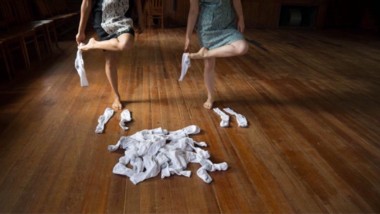Contemporary dance, often considered among the most rarefied of art forms, may not seem like something you’d find in a southern Vermont grange hall. Thanks to Vermont Performance Lab, however, rural southern Vermont has become an increasingly attractive place for dance artists. The Lab, proclaims its website, is meant to be a “performance incubator.”
VPL founder Sara Coffey says, “At the core of our mission is supporting artists—primarily composers and choreographers, and some theater artists as well—as they develop new work. We want to support the creative process and also to foster engagement between artists and folks in our community. We want to be a laboratory for artist research and community engagement. We select between four and six artists for our lab each year for creative residencies. They really take different shapes according to what the artist hopes to accomplish.”
The organization has been around since 2006. Its roster of performers has grown a lot since. Coffey and her husband, Dave Snyder, attended Marlboro College, and, after years in New York City, returned to southern Vermont, where Coffey started VPL and Snyder, more recently, began Guilford Sound, a state-of-the-art recording studio (see “Launching Guilford Sound,” Feb. 6, 2013).
Central to VPL’s mission is the idea of research. That may seem like an odd idea for artists, and Coffey explains that it is a fairly new way of looking at matters of dance: “It is a new idea. The most typical model is artists make their work—somehow—and then it magically appears onstage. From my experience, having managed a few dance companies in New York and being on the presenting and programming end of things, including at Mass MOCA—there was a bit of a gap.
“I created the lab to fill what I perceived as that gap,” Coffey continues. “[What we offer artists goes] beyond just having access to a studio and rehearsal space. Those kinds of spaces—you might have to pay $10 an hour for them, but they’re more readily available. We’re offering access to a studio and to some technical support, but also, in the case of many of our artists, they need to have time or access to people they can talk to, or dig into their research. [Current artist] Dahlia [Nayar] was interested in meeting with our local Asian-American community and collecting stories. One theater artist wrote a new play based in 19th-century New England. We connected him with a course at Marlboro, which he co-taught, and with a local historian—they did a lot of walking through the woods, looking at cellar holes. It fed his creative research.”
When musical group So Percussion visited VPL, Coffey says, they wanted to invite local musicians to be part of their performance. VPL more or less came up with a model of how to efficiently solicit the right talent, a model the group then employed on tour.
“We hope it’s a true laboratory of testing ideas. There will be some successes, but there can be failure,” says Coffey. “We hope that in the process we’re building interest in contemporary performance within or own community—it demystifies ‘contemporary performance,’ makes it more tangible somehow.”
That idea of making contemporary work more accessible to audiences outside of the world of high art is fairly unusual, but it’s important to continuing artistic pursuits that can seem daunting, but are nonetheless culturally vital.
“I think sometimes there can be this air of elitism around live work,” says Coffey. “We’re trying to change the framing of the work, and also trying to give people some tools, some historical context about where this contemporary performance work is coming out of, about postmodern performance traditions and the lineage of the artists we’re hosting. I think people aren’t as familiar with where this work is coming out of, and non-narrative work can be a little bit more challenging. It’s about giving people permission to be open to the work—saying, ‘You’re not stupid. What you’re experiencing, trust that. Allow yourself to think in that way, to go there.”
On May 18, VPL’s current artist, Dahlia Nayar, offers audiences a glimpse of the work she has partly developed in southern Vermont. Northampton-based Nayar boasts a long list of dance credentials (her projects, for instance, have been performed at the National Botanical Gardens, the Kennedy Center and the Complejo Cultural, in Puebla, Mexico), and is a lecturer in the Smith College dance department. Nayar’s project, 2125 Stanley Street, addresses, says the VPL site, “questions of belonging, the challenge of creating habitat in a foreign place, and the personal embodiment of culture and cultural memory, especially in the context of home.”
Nayar and collaborators Margaret Sunghe Paek and composer Loren Kiyoshi Dempster have investigated issues of Asian-American culture with the help of southern Vermonters, and have also taken “context of home” quite literally, as Nayar recently explained. “We’ve experimented with making a soundscape from domestic objects. …One of the things we’re using is clothelines. He’s a cellist, and we’ve experimented with making clotheslines into an instrument. There might also be things he samples from around the kitchen, sounds that evoke this atmosphere.”
For Nayar, what VPL offers seems to have resonated especially well: “The VPL has provided me with the space and time to delve into my creative research,” she says. “We just had time and space to live in the grange. It was a really creative time.”•
2125 Stanley Street: May 18, 7 p.m., Broad Brook Grange, 3940 Guilford Center Road, Guilford, Vt. Performance is free; dim sum dinner: $20/adults, $13/kids 12 and under. Advance reservations strongly recommended online at vplintheworks.eventbrite.com, www.vermontperformancelab.org/events, or (802) 257-3361.



